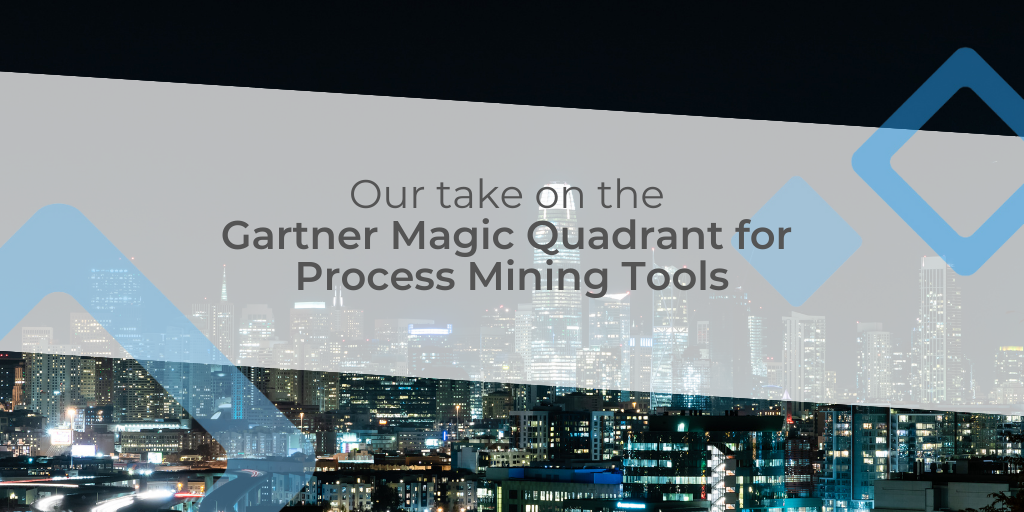In the ever-evolving landscape of technology, businesses constantly seek guidance to make informed decisions. Gartner's Magic Quadrant has become a trusted resource for understanding the market and evaluating the key players.
In this post, we’ll explore the importance of the Process Mining Tools Magic Quadrant, its elements, critical capabilities, the location and outlook of QPR ProcessAnalyzer, and the valuable insights the Magic Quadrant offers for the future of the process mining industry.
The power of Gartner's Magic Quadrant
For vendors and buyers alike, Gartner’s Magic Quadrant is a pretty big deal.
The release of Gartner's first-ever Magic Quadrant for process mining tools in 2023 holds significant importance for the process mining industry both in the present and the future.
The Magic Quadrant is a renowned research methodology developed by Gartner to evaluate and compare technology vendors within a specific market. In this case, the process mining tools market.
Here are a few reasons why the Process Mining Tools Magic Quadrant is important for the industry:
- Objective evaluation: Gartner's Magic Quadrant provides an independent and objective assessment of the leading process mining tool vendors. It comprehensively analyses their capabilities, strengths, weaknesses, and market positioning. This evaluation enables organizations to make informed decisions when selecting process mining tools, as they can rely on Gartner's extensive research and expertise. That being said, there are some drawbacks (which we’ll get to later).
- Market visibility: Inclusion in Gartner's Magic Quadrant enhances a vendor's visibility and credibility within the market. Being recognized as a leader, visionary, challenger, or niche player within the quadrant can significantly impact a vendor's reputation and market perception. This increased visibility can attract new customers, drive sales, and foster growth for the vendor, thereby shaping the competitive landscape of the process mining industry. That being said, from the customer side, you’re almost always in good hands when dealing with a vendor located anywhere in the quadrant due to the depth of vetting and research Gartner does on all of the vendors, which leads us to our next point…
- Buyer confidence: The Magic Quadrant serves as a valuable resource for buyers and organizations looking to adopt or expand their process mining capabilities. The quadrant's evaluation criteria (take it from us – it’s thorough) and graphical representation allow buyers to quickly assess the strengths and weaknesses of various vendors, helping them make more confident and informed decisions. This leads to improved vendor selection and better alignment between the buyers' requirements and the capabilities of the process mining tools.
- Industry benchmarking: The Magic Quadrant provides a benchmark for process mining tool vendors to measure their performance against competitors. Vendors can gain insights into their relative market position, strengths, and areas for improvement. This analysis enables vendors to refine their product offerings, enhance their strategies, and stay competitive in the evolving process mining landscape.
- Future guidance: As the process mining industry continues to evolve, Gartner's Magic Quadrant acts as a compass for vendors and buyers alike. It highlights emerging trends, market dynamics, and future expectations. Vendors can leverage this guidance to align their product roadmaps and strategies with industry demands. Similarly, buyers can gain valuable insights into the direction of the process mining market, assisting them in making long-term investment decisions.
Understanding the four quadrants
Within the Process Mining Tools Magic Quadrant, vendors are positioned in one of four quadrants: Leaders, Visionaries, Challengers, and Niche Players.
The positioning is based on the vendor's performance in terms of their completeness of vision and ability to execute.
Completeness of Vision reflects the vendor’s innovation, whether the vendor drives or follows the market and if the vendor’s view of how the market will develop matches Gartner’s perspective.
Ability to Execute summarizes factors such as the vendor’s financial viability, market responsiveness, marketing presence, sales channels and customer base.
The four quadrants
While all quadrants have their importance, let's focus on the Visionaries quadrant since it’s where our company, QPR Software (and thus, our product QPR ProcessAnalyzer), is placed.
The Visionaries quadrant represents vendors who demonstrate a clear and innovative vision for the future.
They exhibit a deep understanding of the market and possess unique capabilities or features that set them apart. Visionaries often introduce groundbreaking ideas and push the boundaries of what process mining tools can achieve.
When considering a visionary vendor, assessing their long-term roadmap and whether their vision aligns with your organization's goals is important.
Leaders, as the name suggests, are at the forefront of the process mining market. They possess a strong track record of execution and offer comprehensive capabilities.
Challengers are vendors with the ability to execute well but might lack a complete vision for the future.
Niche Players, on the other hand, may excel in specific areas but have a more limited market presence.
Navigating the axes of the Magic Quadrant
The x and y axes of the Magic Quadrant represent different evaluation criteria. The x-axis typically represents the ability to execute, which focuses on factors such as product quality, performance, and customer satisfaction. The y-axis represents the completeness of vision, which encompasses a vendor's innovation, market strategy, and understanding of customer needs. Vendors can move along these axes over time as they improve their offerings and adapt to market demands.
Areas the Magic Quadrant does focus on
The Magic Quadrant focuses on core and critical capabilities that process mining tools offer. These capabilities include:
- Process models and analysis — Models of processes, exceptions and process instances (mostly referred to as “cases”), and employee interactions — the automated discovery of process models, exceptions and process instances, together with basic frequencies and statistics.
- Journey models and analysis — Support for customer interactions, customer journey maps and related analysis — automated discovery and analysis of customer interactions, as well as alignment with internal processes.
- Comparative process mining — Conformance/compliance-checking and gap analysis capabilities — capabilities to check conformance and compliance graphically through overlays, data analysis, and gap analysis.
- Process model enhancement — Intelligent support for process model enhancement — enhancing or extending existing or a priori process models by using additional data from the recorded logs and events.
- Data access and preparation — Data preparation and data quality, data integration, supporting big data — different ways to handle data.
- Business activity monitoring and management — Real-time dashboards with support for key performance indicators (KPIs) that are continuously monitored and enable decision support — real-time or near-real-time connections to continuously monitored and adapted KPIs in dashboards for specific roles in the organization.
- Advanced process analysis — Predictive analysis, prescriptive analysis, scenario testing and simulation — advanced process analytics capabilities that use contextual data.
- Task mining — Inferring useful information from low-level event data available in UI logs. These UI logs describe the single steps within a task done by a user, for example, in using a workstation, based on keystrokes, mouse clicks and data entries.
Areas the Magic Quadrant doesn't consider (and why they're important)
While the Magic Quadrant provides a comprehensive analysis, it's essential to consider other factors beyond its scope.
Commercial terms and price
Commercial terms and price are important considerations that the quadrant doesn't directly address, as these may vary depending on the vendor and the scale of your organization. With some vendors, it’s possible that customers end up paying for the brand or for features they may not actually need and unnecessarily committing to highly unfavourable terms.
Specialization
Additionally, specialization in specific industries or use cases might be crucial for certain businesses, which the quadrant may not explicitly highlight.
Insights into the future and Gartner's stance on the process mining market
The Magic Quadrant and associated research provide valuable insights into the process mining market's future. By examining the vendors' positions, their strategies, and their ability to innovate, we can anticipate trends and emerging technologies in the field.
Gartner's stance on the process mining market is also reflected through its evaluations and can influence the direction and growth of the industry.
In this inaugural process mining magic quadrant, we can clearly see that Gartner is creating a shift in focus away from the automation giants that position process mining as an add-on feature to their automation platforms and towards more specialized process mining vendors offer a true process mining platform that supports all the different use cases.
For us at QPR, this is a great signal – because while automation is an important use case in many industries, the focus on automation only has caused many companies to miss/ignore/overlook a great value potential in favour of automation.
Using the Magic Quadrant for purchase decisions
The Magic Quadrant serves as an excellent starting point for evaluating process mining tools, but it shouldn't be the sole factor in decision-making. It's crucial to align your organization's specific requirements and goals with different vendors' offerings.
Consider factors like ease of implementation, customer support, integration capabilities, and the vendor's reputation. Additionally, reaching out and booking a demo can provide firsthand experience and a better understanding of the vendor's solution.
However, it’s super important to consider the critical capabilities that are most important for your business. You may get exactly what you need now and in the future (and with much better ROI) from a vendor in any of the four quadrants – not only from the market leader.
Conclusion
The Gartner Magic Quadrant for Process Mining Tools serves as a valuable resource for businesses looking to navigate the process mining market. Organizations can make informed purchase decisions by understanding the quadrant elements, critical capabilities, and Gartner's position and perspective on the market.
However, it's essential to complement the Magic Quadrant with a holistic evaluation that considers factors like price, specialization, and individual requirements. Embrace the insights offered by Gartner's Magic Quadrant, and embark on your journey towards optimized and efficient business processes.
Ready to explore the world of process mining tools? Book a demo with us today and experience the power of QPR ProcessAnalyzer firsthand.







